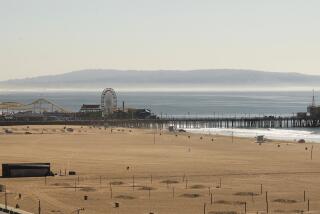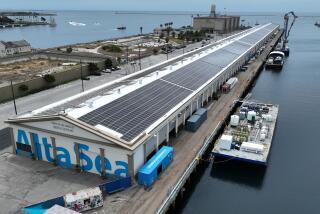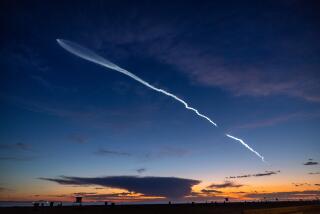Port Commission to Consider 8 Cup Yacht Sites
The Board of Port Commissioners--caught between planning for an America’s Cup regatta in 1991 and the prospect that the Cup may be lost to New Zealander Michael Fay in a maverick race this September--was presented Tuesday with an array of possible sites that could accommodate yacht-racing syndicates.
But port commissioners, led by Louis Wolfsheimer, who questioned whether the Port District should spend as much as $800,000 before the outcome of September’s race, voted unanimously to put off a decision about a specific site until their April 5 meeting.
Estimated costs to develop the potential sites ranged from $10.8 million to $36.6 million, and the locations stretched from Commercial Basin to the Crescent area of Harbor Drive. The best place of all, as determined by consultants, involves the construction of a new, 10-acre peninsula in tandem with covering Convair Lagoon--and its tainted PCB-laden bottom--with an additional 10 acres of dirt.
That proposal, one of eight schemes considered in north San Diego Bay, would cost about $21.4 million to build, though other costs, such as construction of secondary facilities, possible environmental mitigation and the like, could bring the total to more than $30 million.
But perhaps the biggest obstacle of all--should skipper Dennis Conner retain the Cup in September--is the U.S. Coast Guard, which operates its San Diego station adjacent to the proposed new peninsula.
Part of Peninsula in Safety Zone
The trouble is that part of the new peninsula is in the Coast Guard’s flight safety zone. Senior Coast Guard officers say the peninsula--which they characterize as a 100-foot-high wall of masts from the docked Cup yachts--would significantly interfere with the normal departure of their helicopters, a hazard that would become extremely dangerous if a low-flying helicopter develops engine trouble on takeoff and crash-lands.
Right now, a stricken helicopter would ditch in the water.
Capt. David Andrews, commander of the Coast Guard station, said to port commissioners in a prepared statement: “I am frankly amazed at the arrogance of a proposal that so heavily encroaches on Coast Guard operations and property.”
After the meeting, Andrews told reporters that the Coast Guard would consider taking legal action if the San Diego Unified Port District goes ahead with the peninsula plan.
Such a lawsuit would hit at one of the weaknesses of the entire effort to build dockside facilities: the lack of time. Harry Hallenbeck, president of Hallenbeck, Chamorro & Associates, the consulting firm hired by the Port District to prepare the design and facilities plan, said that under any of the eight possible scenarios, the time needed to plan and build America’s Cup docks and piers is extremely tight.
Any delay of several months--be it caused by environmental constraints or, implicitly, by a lawsuit--would jeopardize having the facilities completed in time for the 12-meter World Championships, set for May, 1990, and, in the worst case, for the tentatively scheduled Cup regatta a year later.
Significant Dredging
To complicate matters even more, if the type of boat used in Cup races changes significantly from the traditional 12-meter craft to one with a more radical design, such as the vessel Fay plans to use in September--a boat 90 feet long at the waterline with a draft of about 25 feet--some of the sites proposed by Hallenbeck would require significant and expensive dredging.
Malin Burnham, president of the Sail America Foundation, which is organizing the defense of the Cup for the San Diego Yacht Club, and yacht club Commodore Doug Alford told Port Commissioners there is a possibility a different kind of boat might be used in the future. Alford said efforts are now under way, involving the New York Yacht Club and other past Cup syndicates, to “rationalize” the type of boat that might be used in future races.
Both urged Port Commissioners to continue planning for a 1991 regatta.
It was clear, though, that Port commissioners aren’t ready yet to pick a specific location and are hesitant about making an extensive and expensive commitment to more definitive planning because there is no assurance of a victory in September.
The consultant has already been paid $75,000 and the second phase of his work is to cost $165,000. And in mid-May, Hallenbeck said, the Port District would be asked to spend an additional $500,000 to $600,000 to continue the planning process and keep the timetable on schedule.
Vote to Continue Some Planning
While commissioners refused to pick a specific site Tuesday, they did vote to continue some aspects of the planning, such as identifying the location of the media center as well as pinpointing which state and federal agencies have environmental concerns and what will have to be done to address them.
“I think we should try and spend as little money as possible until we know we have a (1991) race,” Wolfsheimer said.
In presenting the comprehensive report, Hallenbeck said his organization relied on key criteria in making its recommendation. Included in those, he said, was the attempt to place the syndicates in one location, thus creating an Olympic-scale sporting event; the knowledge that whatever the Port District builds, five to seven of the anticipated syndicates will still lease from private boatyards, and that the facilities should result in a long-term benefit to the public, through improved access to the waterfront and improving the environmental quality of the bay.
Another important aspect of the various schemes is that they allow syndicates to bid on three sizes of dock space, from 32,000 square feet with a 160-foot fixed pier, to configurations as small as 16,000-square feet.
While all of the eight schemes, spread over five bayfront locations, had drawbacks and positive elements, Hallenbeck said construction of the 10-acre peninsula south of the Coast Guard station and filling in the Convair Lagoon was the best option.
He said the new site would cure the PCB problem; would provide a protected harbor for race participants; could handle large visiting yachts; would make a public park after the races, and could easily be transformed into syndicate sites again for future races.
Peninsula Minimized Conflict
While Hallenbeck said he and his consulting team were well aware of the Coast Guard’s objections, he said the recommended peninsula--the smaller of two studied at the same location--minimized “conflict with the Coast Guard flight pattern.”
This would be accomplished, he said, by placing the yachts on the side of the peninsula away from the station and by constructing the peninsula’s access road on the other side.
The peninsula would provide 11 large syndicate sites, 16 medium-sized ones and 22 of the smallest.
The Coast Guard said it was willing to compromise by not objecting to the filling in of Convair Lagoon, bringing the Cup complex adjacent to the station’s property line. Capt. Andrews said the Port District should instead move the dock space contained in the proposed peninsula west several hundred yards to space in the East Basin now leased to General Dynamics and Lockheed.
That alternative is one of the eight schemes under study, but Hallenbeck said that while such a configuration provides more syndicate spaces, it is more expensive, makes boat movement in the channel very tight and also faces opposition from General Dynamics, whose leases would have to be bought out. There is also the need to build an expensive 1,000-foot breakwater and find mitigation for eel grass in the vicinity.
The Coast Guard said another option that should be studied is dividing the syndicate sites, which Hallenbeck said is certainly possible but would detract from the ideal of creating a Cup atmosphere by keeping most of the yachts together.


